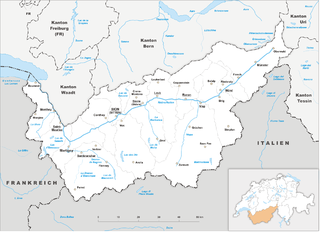
The Val Bavona is a ten-kilometer-long trough valley in the northwestern part of Ticino, Switzerland, in the Vallemaggia District. [1]

The Val Bavona is a ten-kilometer-long trough valley in the northwestern part of Ticino, Switzerland, in the Vallemaggia District. [1]
First human settlements have appeared about 1000 A.D., with a constant number of people living in Val Bavona until about 1600. Repeated natural disasters caused by deforestation have then forced the population back to the lower villages of Cavergno and Bignasco, so that the numerous hamlets of Val Bavona were only used as summer abodes for farmers and livestock keepers. [1]
The prevalent economy of this valley was livestock (goats and cattle), as well as rye farming and logging.[ citation needed ]
During the construction of hydro power plants, the valley received its first and only made-up road in 1957. Before that, people had to use the mule tracks between the settlements. [1]
In 1983, the valley received federal protection status. The late construction of the road, and the fact that the valley is still not attached to the electricity grid, [2] has preserved the historical look of Val Bavona's settlements. [1]
Nowadays, the Val Bavona is mostly known for hiking, a few restaurants, and its holiday apartments that offer a basic comfort.[ citation needed ]
From Cavergno northwards:

The Grisons or Graubünden, more formally the Canton of the Grisons or the Canton of Graubünden, is one of the twenty-six cantons of Switzerland. It has eleven districts, and its capital is Chur. The German name of the canton, Graubünden, translates as the "Grey Leagues", referring to the canton's origin in three local alliances, the Three Leagues. The other native names also refer to the Grey League: Grischùn in Sutsilvan, Grischun in the other forms of Romansh, and Grigioni in Italian. Rhaetia is the Latin name for the area. The Alpine ibex is the canton's heraldic symbol.

Valais, more formally the Canton of Valais, is one of the 26 cantons forming the Swiss Confederation. It is composed of thirteen districts and its capital and largest city is Sion. The flag of the canton is made of thirteen stars representing the districts, on a white-red background.


Valle Maggia is an alpine valley in the Vallemaggia district of canton of Ticino, the Italian-spoken canton of Switzerland. The valley is formed by the river Maggia and is situated between the Centovalli and Lago Maggiore as well as the Valle Verzasca in the East.

Obwalden or Obwald is one of the 26 cantons forming the Swiss Confederation. It is composed of seven municipalities and the seat of the government and parliament is in Sarnen. It is traditionally considered a "half-canton", the other half being Nidwalden.

Vals is a village and a municipality in the Surselva Region in the canton of Graubünden in Switzerland. On 1 January 2015 the former municipality of St. Martin merged into the municipality of Vals.

Lumnezia is a valley region and a municipality in the Surselva Region in the Swiss of canton of Graubünden. The former municipalities of Cumbel, Degen, Lumbrein, Morissen, Suraua, Vignogn, Vella, and Vrin merged on 1 January 2013 into the new municipality of Lumnezia. It covers the Val Lumnezia, a Swiss high alpine valley. Its upper regions are among the most remote areas in the Swiss Alps. The official language is Romansh.

Samnaun is a high Alpine village and a valley at the eastern end of Switzerland and a municipality in the Engiadina Bassa/Val Müstair Region in the Swiss canton of Graubünden.

Lü is a village in the Val Müstair municipality in the district of Inn in the Swiss canton of Graubünden. In 2009 Lü merged with Fuldera, Müstair, Santa Maria Val Müstair, Tschierv and Valchava to form the municipality of Val Müstair.

Valchava is a village in the Val Müstair of the canton of Graubünden (Grisons), Switzerland. It was an independent municipality in the district of Inn until on 1 January 2009 Valchava merged with Fuldera, Lü, Müstair, Santa Maria Val Müstair and Tschierv to form Val Müstair.

Elm is a village, and former municipality, in the municipality of Glarus Süd and canton of Glarus in Switzerland. Elm lies in the valley of the Sernf river, and consists of the village of Elm itself, and the hamlets of Sulzbach, Schwändi, Müsli, Untertal, Vogelsang, Töniberg, Obmoos, Steinibach and Wald.

Lavizzara is a municipality in the district of Vallemaggia in the canton of Ticino in Switzerland.

Cevio is the capital of the district of Vallemaggia in the canton of Ticino in Switzerland. In 2006 Cevio grew by incorporating the villages of Bignasco and Cavergno, previously municipalities in their own right.
Stampa is a former municipality in the Maloja district of the Swiss canton, Graubünden. It is now part of the municipality of Bregaglia.

Brontallo is a village and former municipality in the district of Vallemaggia in the canton of Ticino, Switzerland.

Fusio is a village and former municipality in the district of Vallemaggia in the canton of Ticino, Switzerland.

Menzonio is a village and former municipality in the district of Vallemaggia in the canton of Ticino, Switzerland.

The Schams is a section of the Hinterrhein valley in the Swiss canton of Graubünden.

The Val Medel is a righthand side valley of the Surselva valley in Graubünden, Switzerland. It is approximately 15 km (9.3 mi) long and stretches from Disentis to the south, where it ends at Lai da Sontga Maria reservoir on Lukmanier Pass. There is a road through the valley and over Lukmanier Pass into Ticino.

The Cristallina Hut is a mountain hut of the Swiss Alpine Club, located in the Lepontine Alps in the Swiss canton of Ticino--specifically, On the west side of the Cristallina mountain.